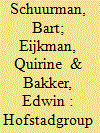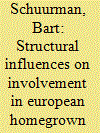| Srl | Item |
| 1 |
ID:
142529


|
|
|
|
|
| Summary/Abstract |
Despite the Dutch Hofstadgroup's status in the literature as a prime example of a homegrown Salafi-Jihadist terrorist network, the authors, using newly available primary sources, argue that this classification is to a large extent unwarranted. The lack of a rudimentary organizational structure, the existence of divergent views on the legitimacy and desirability of political violence, and the absence of collective action in pursuit of a violent goal rule out labeling the Hofstadgroup as a terrorist organization or network for the largest part of its 2002–2005 existence. A smaller subgroup of extremists did begin developing into a proto-terrorist inner circle from late 2003 onwards. In 2004, this extremist core brought forth the murderer of filmmaker Theo van Gogh. But it was only in 2005, when the remnants of the inner circle tried to resuscitate the Hofstadgroup in the wake of the arrests that had followed Van Gogh's death, that these individual actions were replaced by the communal efforts necessary to warrant the “jihadist network” label often ascribed to the Hofstadgroup. Arguably the most archetypical aspect of the Hofstadgroup case is its ability to illustrate the deleterious effects of the ongoing scarcity of primary sources-based research on terrorism.
|
|
|
|
|
|
|
|
|
|
|
|
|
|
|
|
| 2 |
ID:
159886


|
|
|
|
|
| Summary/Abstract |
This article empirically assesses the applicability of structural-level hypotheses for involvement in terrorism within the context of European homegrown jihadism. It uses these hypotheses to study how structural factors influenced involvement in the Dutch “Hofstadgroup.” Structural factors enabled the group’s emergence and its participants’ adoption of extremist views. They also motivated involvement in political violence and a shift in some participants’ focus from joining Islamist insurgents overseas to committing terrorism in the Netherlands. Finally, structural factors precipitated an actual terrorist attack. No support is found for the frequently encountered argument that discrimination and exclusion drive involvement in European homegrown jihadism. Instead, geopolitical grievances were prime drivers of this process.
|
|
|
|
|
|
|
|
|
|
|
|
|
|
|
|